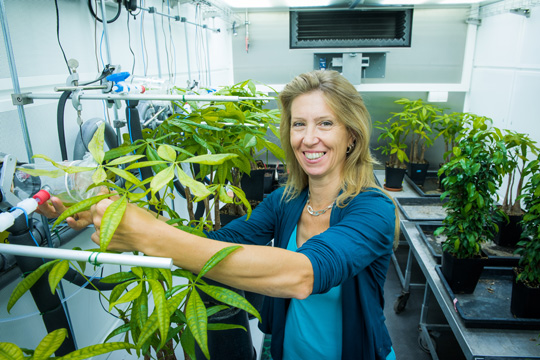Stress in a Two Chamber System
Freiburg, Oct 19, 2017
A microscope makes the structure of a plant visible. It shows its leaves' cells and the chlorophyll within them. But that’s about it. The research of Professor of Ecosystem Physiology Christiane Werner takes a far more in-depth look than that. Werner has received a 1.8 million euro European Research Council (ERC) Consolidator Grant for her analyses. To mark the tenth anniversary of the ERC grant and its fifty recipients, the University of Freiburg is taking a look at selected projects that the grant has financed. A series features portraits of ten of the scientists who’ve received them.

In two light chambers built next-door to one another, the researchers are investigating how changed climate conditions affect vegetation. Photo: Klaus Polkowski
Werner first identifies the intramolecular metabolic pathways of a plant. The biologist looks not only at what is metabolized within the plant, but also what the plant emits into the atmosphere. Werner is now taking her research a step further. She wants to understand more than just how plants work in normal conditions. The researcher is going beyond that to investigate how they respond to stress caused by drought, frost or other weather extremes as well. The sensational thing about her work is that Werner is analyzing these substances in living plants. Individual molecules must no longer be synthesized from collected leaves in order to take measurements.
The biologist had already received the ERC grant when she came to Freiburg from Bayreuth in 2015. Since her dissertation, the she has been investigating the adaptation strategies of plants. “It’s just unbelievable how much plants can withstand and buffer,” she says. Werner wrote her doctoral thesis at the University of Bielefeld. After working in a postdoctoral position within a European Union network for stable isotope ecology, she went on to obtain an assistant’s position, which then became a junior professorship for ecophysiological plant ecology. In 2012, she accepted an appointment from the University of Bayreuth to a full professorship of agroecosystems ecology.
When plants discriminate
When Werner talks about her work, words like “super,” “exciting,” and “cool” are heard again and again. She loves what she does. Werner says that the ERC allows a person to research “outrageous things” now and then. And Werner’s plans are just a bit out of the ordinary. On the ground floor of her institute by the airfield there are two light chambers that have been built next to each other. Inside each, hanging from holders, are seven glass containers known as cuvettes. The openings face down so that plants can be placed in them from below.

Christiane Werner places a plant in the cuvette. She uses these to measure incoming and outgoing carbon dioxide, including its isotope value, and scent molecules that are being emitted by the plant. Photo: Klaus Polkowski
There are three measurement devices in one of the chambers. Werner explains, “Two of the devices measure the carbon dioxide flowing in and out of the cuvette, including the isotope values. The third device, which is called a PTR-MS-TOF measures everything else the plant emits in the form of volatile organic elements.” Such as scent molecules and oxidants, she adds. In English, they’re known as volatile organic compounds, or VOCs, for short. They too, have isotopes. Within a chemical element, not all nuclei are the same. They always have the same number of protons, but the number of neutrons may vary. These different varities of an element are called isotopes. Sometimes they are heavier, other times, lighter. The isotopes present indicate whether or not a plant is stressed. It doesn't matter to a human how many more or less acidic and hydrogen isotopes there are floating around in a glass of water. But for plant, that’s extremely important. “An enzyme that’s key for photosynthesis doesn’t like heavy carbon isotopes at all,” elaborates Werner. “If the plant is doing well, it discriminates between these isotopes during the uptake of carbon dioxide. If the plant is ailing, it discriminates less,” she continues, adding that these are clear signals and she measures them in the leaves, branches and in the VOCs.
Behavior patterns and test series
In order to better understand how plants react when they are under stress, the leaves in the cuvettes are fed pyruvate. Pyruvate is in the C3 group – meaning it is made up of three carbon atoms and is also present in the plant as a metabolite, for example, while breaking down a C6 sugar molecule. The effect is magnified through the use of highly marked pyruvate – a form with as many heavy carbon isotopes as possible.
The exciting thing is what happens then. How does the plant incorporate the pyruvate into its metabolism? How does it break down molecules and where does it put the carbon that's been split off? Does it stay in the plant, or is the pyruvate emitted? If it remains in the plant, then how many of the three carbon atoms separate off and are emitted into the air as VOCs? Werner and her team have been following metabolic pathways of plants and have observed clear behavior patterns. Test series are still underway in the cuvettes. But Werner has big plans. Under the auspices of her ERC, she wants to travel to Arizona in the US. This is where Biosphere 2 is located. The domed structure houses a closed, 1.6 hectare ecosystem. That’s where Werner wants to explore how plants interact with the atmosphere. In just over a year, she should be ready to go.
Stephanie Streif

